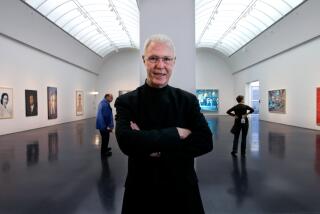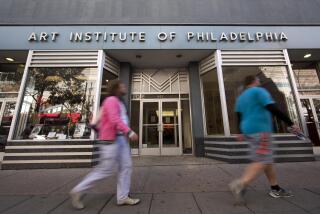Whittier College and the Arts : Joint Program With L.A. Art Institute Aims to Bolster Enrollment, Save Money
- Share via
WHITTIER — In an era of tight money and intense competition for new students, Whittier College and a Los Angeles art institute have launched a program aimed at bolstering each other’s enrollments without breaking the bank.
Beginning this fall, the two colleges will offer a joint art major, leading to dual degrees, that educators say will take advantage of the respective strengths of the two small, private schools.
Students will spend three years at Whittier getting a general liberal arts education, then transfer to the Otis Art Institute of Parsons School of Design in downtown Los Angeles for two years of concentrated art studies.
Because there have been fewer high school graduates to draw from in recent years, officials at the two colleges contend that the agreement has added a novel--and attractive--weapon to their recruiting arsenal.
Sought Ways to Expand
It also appears to satisfy both colleges’ need to control spending.
In recent years, Whittier has sought ways to expand its art course offerings to keep pace with student demands for a more diversified department.
And at Otis Parsons, the West Coast campus of the New York-based Parsons School of Design, administrators say they lose a number of students each year who want to pursue art careers but believe the curriculum there is too narrowly focused.
“This makes excellent use of limited resources of two small institutions,” said Robert B. Marks, vice president of academic affairs and dean of faculty at Whittier. “Everyone benefits. . . . We get more students majoring in art, which enriches our campus. . . . Parsons gets students with a broader view of the world.”
This is one of the first joint academic ventures between two private California colleges or universities that involves a non-technical field of study. In the past, small liberal arts colleges, including Whittier, have had similar arrangements for students who want to major in engineering or architecture. But Hans Giesecke, assistant vice president of the 123-member Assn. of Independent California Colleges and Universities, said the Whittier-Parsons program may be the first involving a non-technical discipline.
‘Join Hands to Save Money’
“This may be a sign that even in the area of liberal arts,” Giesecke said, “small colleges are choosing to join hands to save money rather than embark on costly expansion programs.”
In Whittier’s case, that is right on the money.
At least three major building projects are in the works at the college--an $8 million performing arts center, new student housing and an expansion of the library.
That leaves little for any on-campus changes or additions to the college’s art department, Whittier spokesman Donald Stewart said. “It’s just not on the boards, and probably won’t be for some time,” he said. Thus, the Whittier-Parsons project fills the void, Stewart said, because it allows the college, in a sense, “to pick up personnel and facilities without spending much money.”
The unsettled enrollment picture is another reason Whittier officials say they are shy about expanding academic departments on the 1,050-student campus. Until last year, enrollment at the Quaker college had gradually slumped from a high of 2,000 in 1970, due in large part, officials said, to similar student declines on the high school level.
As a result, Whittier stepped up its recruitment of minorities, launching aggressive campaigns to woo both Latinos and blacks to the mostly white campus. The Whittier-Parsons venture is an extension of that recruiting drive.
Six entering freshmen have been accepted for the program in the fall, and plans are to have as many as 25 in the program at the end of three years.
“Those are kids that probably would have never considered Whittier, but because of the ties to Otis Parsons are now going to come here,” Stewart said. “And that is a direct financial benefit to this college.”
Professors’ Brainchild
The cooperative effort was the brainchild of two Whittier art professors, who pitched the concept as a way to enlarge the department.
Art has always been a part of the liberal arts menu offered on the century-old campus at the base of the Puente Hills. But the focus has been fine arts, and in recent years the clamor among students, according to campus officials, has been for commercial art training--fashion designing, photography, interior architecture and layout and advertising.
Professors Paula Radisich and Susan Meyers recognized the demand and last fall hit on the idea of marrying Whittier to a Los Angeles design and art school.
The pair found a willing partner in Roger Workman at Otis Parsons. Dean of the art institute since the summer of 1985, Workman said he had been looking to link up with another college to halt the flight of students. When Radisich, chairman of the Whittier art department, and Meyers sketched the idea for Workman, he bought it.
Pilot Program
Earlier this year, faculty members at the two colleges approved the concept, and the pilot program was launched.
Students who complete the five-year program will receive two degrees: a bachelor of arts from Whittier and a bachelor of fine arts from Otis Parsons.
Getting an education at either institution is not cheap. Tuition next year will be $9,350 at Whittier and $7,500 at Otis Parsons. Officials estimate that it will cost students more than $45,000 just in tuition to finish the school by graduation day.
Students who apply must submit high school transcripts, test scores and an art portfolio, and pass admissions at both colleges.
During the first three years, Whittier will be the students’ home campus, but they will take one course a semester at Otis Parsons, a conglomeration of buildings near MacArthur Park on Wilshire Boulevard just west of downtown Los Angeles. Twice a week the students will make the 40-minute trip to Otis Parsons to attend classes there.
‘3-2’ Program
The final two years of the “3-2” program, as it is known, will be at Otis Parsons, which was a county-financed art academy until 1978, when the Parsons School of Design in New York bought the buildings and opened a West Coast campus. Before Parsons stepped in, the academy had offered a two-year master’s program for art students. Parsons opened it to undergraduates and offered four-year degrees. Besides New York and Los Angeles, the art institute, the nation’s largest, also has a campus in Paris.
Workman said the Whittier cooperative is similar to one Parsons has had in New York with the New School for Social Research, another private college.
Although Otis Parsons is a four-year program, offering general education courses, the institute’s top administrator contends that in some corners the curriculum is considered less than well-rounded.
“I think we lose 15 or 20 students every year because they or their parents believe that going to art school is not getting an education,” said Workman, the dean of the 750-student art institute. “Now we can offer art students an alternative . . . a college setting with a strong liberal arts foundation.”
Parents Reassured
That’s important, Workman said, to parents who are often “aghast when Johnny comes home” from high school and says he wants to pursue a career in art. “The parents first reaction is ‘How did we fail?’ That’s nonsense. Artists and designers are not stupid. . . . But some parents feel more comfortable if their kids start somewhere more traditional and then come to us.”
Whittier is about as traditional a college as one can find. Surrounded by quiet residential streets in the conservative foothill community, Whittier is a stable campus, which is why Marks, the academic affairs vice president, is excited about the prospects of the Parsons exchange.
“Students who attend Otis Parsons are often much more avant garde than those at Whittier,” Marks said. “As a result we think this program will bring a different type of individual to campus . . . one that will enrich and diversify our student body.”
At the same time, Meyers, who teaches scuplture and ceramics at Whittier, contends that students who start at Whittier and then go to Otis Parsons will be better able to handle the rigors of the commercial art world. A liberal arts foundation, she said, “is important for problem solving” and will arm students the kind of worldly knowledge needed to excel in the competitive marketplace.
Adjustment Needed
Workman, however, is worried about the adjustment students will have to make between the relatively placid world of Whittier and the noisy urban setting of Otis Parsons. In fact, he said, one of the art institute’s advisers will be assigned to help students cope with differences between the two campuses.
“Whittier is so rural, so out-of-the-way and safe that some art students who thrive on the beat of a big city may struggle,” said Workman, a Whittier alumnus himself who graduated with a psychology degree in 1973.
One student who has enrolled in the Parsons program did so because the settings are so dissimilar.
Sabrina Kiechler, a senior at Whittier’s La Serna High School, said the chance to experience both worlds prompted her to apply for the Parsons program. At first, she did not want to go to college so close to home, but the chance to sample art school without jumping headlong into a specialized program straight out of high school appealed to her.
“It was just too good to pass up,” Kiechler said. “This way I can get used to it at my own pace. I am very excited.”
More to Read
Sign up for Essential California
The most important California stories and recommendations in your inbox every morning.
You may occasionally receive promotional content from the Los Angeles Times.













